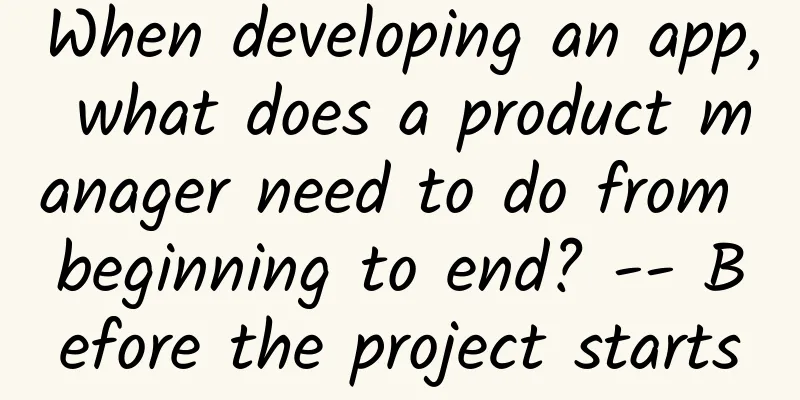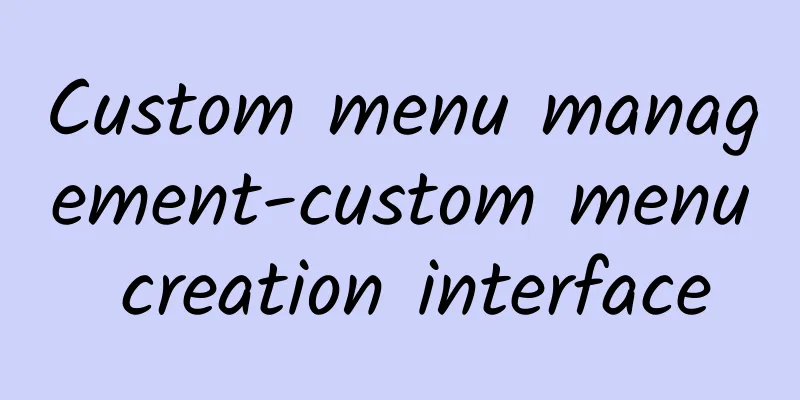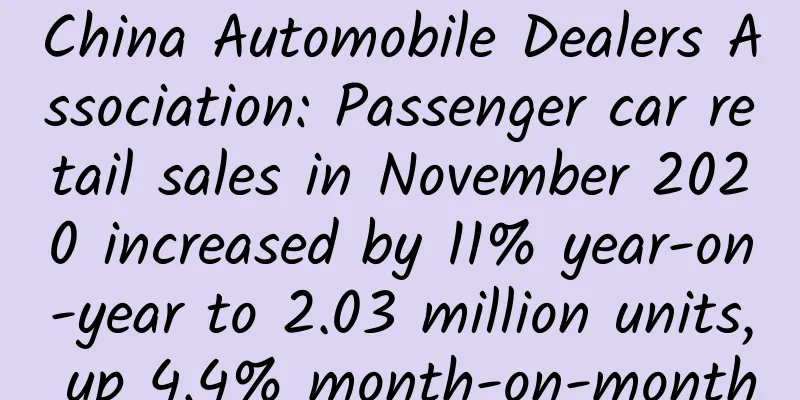When developing an app, what does a product manager need to do from beginning to end? -- Before the project starts

|
I have been working in product management for more than a year, but I have been suffering from confusion of one kind or another. Many people want to work in product management, or the boss wants to take on the product position himself when starting his own business, but they have a vague understanding of the product position. Some think it is purely about drawing prototypes, some think it is about doing project management to track project progress, and some do competitive product analysis for the boss. In fact, these are not the core and focus of product managers. In more mature companies, due to the growth of products and the increase in personnel, in order to facilitate collaboration and communication, positions will be clearly detailed, such as product managers, interaction designers, UI designers, user experience analysts, data analysts, operations, etc. However, product managers in entrepreneurial companies often have multiple positions. Startup companies pursue efficiency and cost maximization, and have no energy to divide positions so finely. Below, I will examine the whole process from the perspective of an entrepreneur or a product manager responsible for a product project to see what a product manager needs to do from scratch. From product concept to output to process Before doing anything, you must first consider the user needs, business value, and technical difficulty behind it. Only when users have demand will your product be used; only when its business value is established can it bring profits to the company, after all, the most basic goal of a company is to make a profit; only when the overall technical evaluation is feasible can the entire project be implemented. In today's Internet startups, everyone is pursuing "speed", such as financing in 2 months, more than 1 million users in April, and listing on NASDAQ in 3 years. However, these are all the appearances of other people's successful startups. Little do people know that the premise of doing anything is that you have to understand what you are doing. Of course, it is not ruled out that some people with courage and good luck can succeed casually, but that is just an individual case and is not worth investigating. 1. User needs 1.1 Product Positioning During the execution of the project, we often fall into a situation where a bunch of people are together and the atmosphere of the discussion is very emotional. A says that the button here is not good, B says that this place should be done like other people's APP, and C says that you are all wrong and that this module should not be replaced with this one. Frequent participation in such discussions will be extremely time-consuming and physically demanding. Several hours will pass, but once the meeting is over, no results will be obtained. In most cases, there must be a problem with the product positioning. The person who executes must clearly understand what the product is used for and who it is for before discussing the specific details normally. If you discuss for a long time with enthusiasm and arrogance, and find that there is no result and that the discussion of the meeting has gone astray, you might as well return to the essence and think about what our product positioning is.
Product positioning includes two major contents: product definition and demand definition. The content to be analyzed in product definition includes the user group, main functions and product features of the product. For example, if you want to start a business and develop a mobile recruitment APP, what should a product manager do first? China has a huge number of employed people every year, and the industries are also diverse. So you have to think about what kind of people your product will serve. If you want to serve people from all industries, it is impossible. First of all, it is very difficult for a small company to integrate recruitment information from so many industries. In addition, not everyone in every industry is so receptive to the Internet. Through data analysis and research, we found that the country now encourages entrepreneurship, and the peak period of entrepreneurship will inevitably generate a large demand for manpower, especially at the scene, almost all entrepreneurship is related to the Internet, and people working in the Internet industry are also very receptive to APPs, at least they are willing to try. So you regard the Internet industry practitioners as the users of your product. After analyzing other recruitment apps, you find that these apps have many problems. For example, I want to find a job in Xi'erqi, Beijing, but many apps currently do not have position screening; although you can apply for jobs abroad, the feedback you get is very limited; there is too little information about the company to be known; before the application is established, as a job seeker, you want to know who the boss of the company is; now it is the Internet age, electronic resumes are completely fine, why do recruiters need to print their resumes every time they are recruited? You should know that printing resumes is not very convenient for job seekers, because they can be changed at any time, which is very inconvenient for job seekers. So you plan to make this app, and its special functions are 1. Positions support the classification of the location of the company; 2. The recruiter should give job seekers feedback from time to time; 3. Cancel paper resumes. The main function is recruitment. Now we name the app Feige Recruitment.
The analysis of demand definition includes three aspects: target users, usage scenarios, and user goals. The target users are the types of people who will use your product; the main function refers to what your product is used for, whether it is a tool, social networking, or something else; what is the difference between your product and other products on the market, this is the product feature. Just now, we have clarified the applicable population, main functions and product features of the APP. Some recruitment APPs on the market are headhunters who are specifically targeting those who want to change jobs. Who are the target users of your APP? Based on the analysis of special functions and user pain points, it is analyzed that the target users of the product are those who want to find a job in a specific location, such as those who have settled in Houshayu, Beijing, and hope to work in Wangjing; when you have just moved to Huilongguan, you are facing a job change, and you may tend to look for a job in Xi'erqi. 1.2 Demand Analysis The above is all about product positioning. After completing these, the next step is competitor analysis and user research. On the one hand, this is a certain verification of our needs, and on the other hand, it is also an opportunity for us to directly contact users and see what needs they have. 1.3 Demand Screening Early demand screening is a very difficult task. If the product manager is the boss himself and has a clear mind, it is fine. However, it is easy to get stuck in the vast amount of demands and go off track during the discussion. After the discussion, it seems that all functions are needed. This function is useful and must be added; that function is so fun that users must find it interesting. These words are always based on personal subjective assumptions. They often sound reasonable at the time, but they cannot stand up to scrutiny afterwards. Therefore, we need to always grasp our product positioning and priority, and never blindly make many fearless sacrifices and struggles in this area (make fewer unthinking, snap decisions, and decisions without thinking).
During the early demand screening, many demands will appear. Some of them we cannot immediately judge as good. These ideas may become the inspiration for our product iteration in the future and bring broader ideas to the development of the product. Good management, respect for everyone's ideas, and record and download when there is ambiguity will be of great help to the promotion and progress of the meeting. 2. Commercial Value Market demand documents and business demand documents are generally more mature in large companies. In small companies, most decisions are made by the boss himself. The boss may not make this or that document, but he will definitely make a basic understanding, or he himself knows a certain industry very well. These two documents are neither redundant nor cumbersome. It is very necessary to spend some time to deeply understand the industry and users before starting the project. The specific document details are not elaborated here, and there are many references on the Internet. 3. Technical Assessment
As someone who is not from a technical background, I will not go on here any more. Respecting developers and getting along well with them will be very helpful in promoting the product. |
<<: Don’t know how to develop VR games? Unity 5.3 official VR tutorial is released - Series 2
>>: Python Development: Introduction to Cache Mechanism
Recommend
The rooster’s crowing is so loud, why haven’t you gone deaf yet?
Gulp! ... My eyes are hurt. |Giphy How loud is a ...
These are the scariest animal sounds on Earth, and you probably hear them all the time
Lions, tigers, bears, when these animals roar, th...
Rise of the Tomb Raider review: Lara Croft's best adventure yet
I am a half-Tomb Raider fan. I remember when I wa...
110, happy holidays!
“I am a police officer” Anytime, Anywhere Hear th...
Mobile development fifth: 6 most popular positions for new programmers
[Bole Online Guide]: In March this year, FreeCode...
Sharing of operational experience: 6 ways to increase user activity!
How to maintain and increase activity and improve...
World Hemophilia Day丨Care for "glass people", forward for love!
April 17, 2022 It is the 34th World Hemophilia Da...
Mobile technology for the masses: An all-in-one introduction to Android
Enter the mobile world of Android and build your ...
Can drinking pre-opened coconut water kill you? Can coconut water purify amniotic fluid? The truth is out!
Coconut is a fruit loved by many people. Whether ...
"WHO warns: Sweeteners can cause diabetes and cardiovascular disease"? Sugar-free drinks are no longer acceptable?
On May 15, the World Health Organization released...
This inconspicuous "little white flower" actually has its own festival
Other names: bellflower, grass bell, royal shadow...
Kuaishou Magnetic Taurus Brand Marketing Strategy Guide for Q1 2022
With the rapid development of live streaming e-co...
Short video advertising operation monetization conversion method!
The main purpose of Kuaishou/Douyin promotion is ...
Former Facebook Engineer Qin Chao丨Facebook Growth Secrets and Practical Methodology
Last weekend, I attended a salon event called &qu...
Qin Zhiqiang: How to sell virtual products and public account SEO on WeChat, and easily earn 10,000 yuan a month by working part-time at home
Two years ago, knowledge payment became popular, ...









